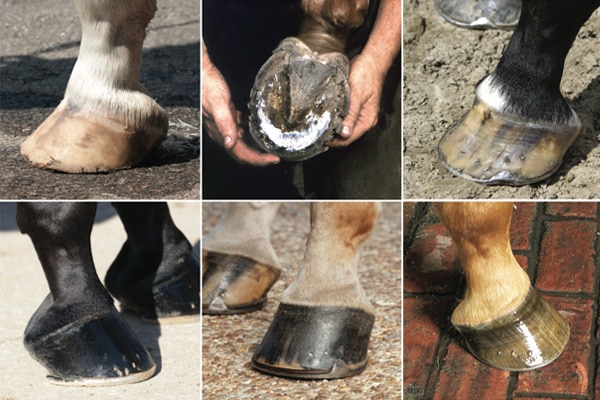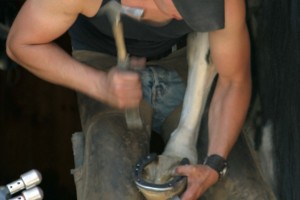Parts of a Horse Hoof and Supporting Healthy Feet

You pick out your horse’s feet every time you ride. You put dressing on when they’re dry, and you treat thrush when it crops up. Sometimes he throws a shoe, but usually you just find the standard farrier bill tacked to your stall door every six weeks. In other words, your horse’s feet are average, middle-of-the- road, “nothing special” hooves.
But would you ever use any of those words to describe your horse? No way! You know that your horse is special. He’s unique and wonderful, and he deserves better-than-average feet. After all, your horse’s hooves are the foundation for everything he does, so make sure you’re giving him everything he needs to make his hooves their best.
Hoof Glossary
BARS - Inward folds of the hoof wall from the heels on the underside of the foot.
COFFIN BONE (aka “distal phalanx” or “P3”) - Large bone inside the hoof.
CORONARY (CORONET) BAND - Junction of the skin and hair with the hoof wall, where new hoof growth begins.
FROG - Soft, wedge-shaped tissue in the center of the bottom of the hoof.
HEEL - Back portion of the hoof. Includes the hoof wall, sole, frog and heel bulbs.
HOOF WALL - Part of the hoof that can be seen when the horse is standing. Divided into toe, quarter and heel. Made of horny material that grows continuously.
HORN - Hard tissue that makes up hoof wall. Consists mostly of keratin, the main structural protein of the epidermis.
LAMINA - Interlocking membranes that hold the hoof wall to internal hoof structures.
NAVICULAR BONE (aka “distal sesamoid bone”) - Small bone inside the hoof. Lies behind the coffin bone and under the pastern bone.
QUARTERS - Side portions of the hoof wall, between the toe and the heels.
SOLE - Hard tissue on the bottom of the hoof surrounded by the wall, bars and frog.
TOE - Front portion of the hoof.
WHITE LINE - Junction between the hoof wall and sole on the bottom of the hoof.
Healthy Feet, Healthy Horse
 The outer structures of your horse’s hooves are just one piece of the largest organ in his body – the skin. That means that by providing the nutrients that support healthy hooves, you’ll also be promoting healthier skin, a shinier coat and a longer, stronger mane and tail.
The outer structures of your horse’s hooves are just one piece of the largest organ in his body – the skin. That means that by providing the nutrients that support healthy hooves, you’ll also be promoting healthier skin, a shinier coat and a longer, stronger mane and tail.
Many factors influence your horse’s hooves, including his genetics, his environment, and the type of work he does. However, all horses need certain nutritional components in their diets in order to have strong hooves. These nutrients include specific vitamins, minerals, amino acids and essential fatty acids. Your horse’s body needs them to produce healthy connective tissues, which compose the wall and sole of the hoof. If your horse’s hay and grain alone aren’t meeting his hoof health needs, a hoof supplement can help!
The Basics of Biotin
Biotin, a B vitamin, is the most common ingredient in many hoof supplements. Vital to the healthy growth of durable hooves, Biotin plays a key role in the formation of collagen. Collagen helps make up connective tissues throughout the body, including skin, bones, cartilage, tendons and, of course, hooves. Research studies show that long-term, daily supplementation of Biotin may improve the growth rate and hardness of hooves, especially in horses with poor quality hoof horn.
Beyond Biotin
Biotin alone isn’t enough. In fact, a very small portion of hoof problems stem from Biotin deficiency alone. As a result, quality hoof supplements take a more comprehensive approach.
Amino Acids: Lysine, Methionine and Threonine are all essential amino acids, meaning they must be provided in the diet since the body can’t create enough of its own. They are also all limiting amino acids, which means that if they’re not provided in sufficient levels, they can compromise the body’s ability to make protein, which is vital for the formation of connective tissues. Methionine in particular contains sulfur, which enables the cross- linking of connective tissue fibers that give hooves their strength.
Minerals: Zinc is a micro-mineral with many important roles, including the formation of keratin, the structural protein that gives hooves their hardness. Other minerals that support healthy hooves include Copper, Cobalt and Manganese.
Healthy Fats: Fatty acids like Omega 3s and 6s aren’t just important for healthy skin and a shiny coat (remember all connective tissue can benefit from the same key ingredients). These healthy fats are necessary for proper moisture maintenance and pliability of the hoof structure. Look for a hoof supplement that contains Lecithin, Soy, Flax Seed or Rice Bran, to provide these healthful fatty acids.
Results You Can See
You can’t rush perfection. Plan to feed a hoof supplement for at least six months to see results — it takes time for a new, healthier hoof to grow.
Hoof Supplements to Try
Healthy hooves start on the inside. Give your horse the comprehensive nutritional support he needs for strong, healthy hooves, by adding one of these supplements to his diet. View our hoof supplement comparison chart at SmartPak.com.